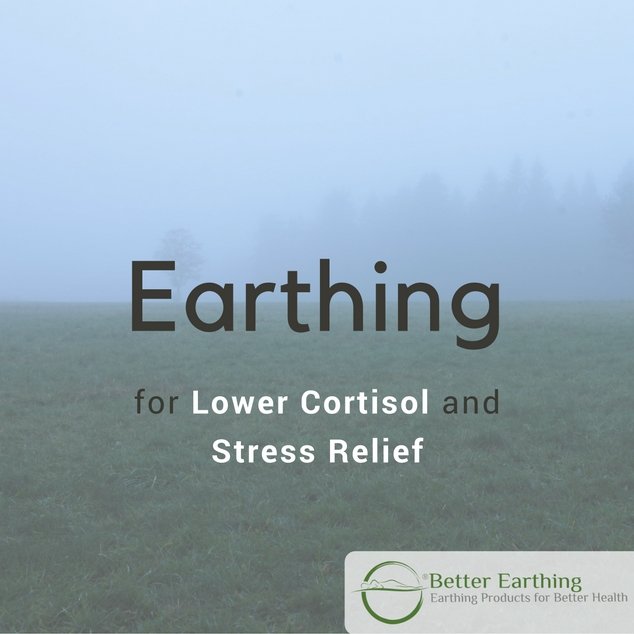Cortisol and Stress

There is a well-known link between cortisol and stress. Cortisol is a hormone secreted by the adrenal glands and along with adrenaline is responsible for our “fight or flight” response to perceived danger.
Cortisol has many vital functions within the body, but when its levels become too high, this can result in a whole host of health problems including stress, fatigue, weight gain, and hormonal imbalances.
Earthing or grounding is a natural way of keeping your cortisol levels within a normal range and resetting your biological rhythms. It utilizes the earth’s subtle electrical charge to keep your body in balance and can help with a wide range of conditions, both physical and emotional. See a full list of earthing health benefits here.
The Role of Cortisol in the Body
Cortisol is involved in the fight or flight response to stress but also has several other important functions within the body.
Cortisol levels should peak in the morning, causing you to wake from sleep and stay alert throughout the day. It keeps your reactions sharp and helps with cognitive functions such as learning and memory.
It also plays an important role in homeostasis, keeping your biological systems in a constant state of balance. It contributes to the regulation of fluid levels, blood pressure, and blood sugar. Because of its role in the metabolism of sugars, cortisol also affects the action of other hormones such as insulin, and plays a part in controlling body weight.
Another function of cortisol is reducing inflammation. The inflammatory response is a result of the immune system’s natural protective function. The role of cortisol is to switch off this response and prevent inflammation from becoming chronic and harmful.
Our Natural Stress Response
When we are stressed, our adrenal glands kick in. The hormones adrenaline and cortisol are released. Together these have the effect of increasing the heart rate, increasing circulation to the muscles, and releasing stored energy from cells. They suppress the immune and digestive systems and increase mental alertness.
This combination allows us to make quick decisions and act on them effectively. This is what is known as the fight or flight response and is a healthy reaction to danger, whether it be genuine or perceived.
When our Natural Stress Response goes Haywire
The fight or flight response is a vital way of protecting ourselves against danger. Once a stressor has been dealt with, this hormonal reaction should shut off and cortisol levels should return to normal. However, in some cases, this does not happen, which is when problems occur.
Thousands of years ago, our ancestors faced daily challenges such as encountering wild animals. For them, the flight or fight response was life-saving, allowing them to quickly decide whether to face the threat head-on or run away.
In modern times, we face different stresses; work, money and relationships can cause us to worry daily. However, humans have not evolved much since prehistoric times, and we still have the same physiological reaction to these problems. When our worries are ongoing, our adrenal glands carry on working, putting us into a constant state of stress. Cortisol levels do not have a chance to return to normal, and all of its vital functions are thrown into disarray.
Symptoms of High Cortisol
The symptoms of high cortisol can affect the whole body. The most common symptoms are emotional stress and anxiety. This can be accompanied by feelings of fatigue, and although you might feel tired, high cortisol levels can cause insomnia, keeping you awake at night.
Having high cortisol can result in other hormonal imbalances. The function of insulin is inhibited, causing changes in appetite and weight gain. As more fat is stored around the abdomen, this increases the risk of conditions such as diabetes and heart disease. The sex hormones can also be affected causing irregular menstruation in women, loss of libido, and infertility.
Other symptoms related to high cortisol include acne, puffiness of the face, increased thirst and urination, digestive issues, low immunity, and a higher risk of fractures.
Why High Cortisol is Hazardous to Your Health
High cortisol increases the risk of many serious diseases. It can interfere with your metabolism causing weight gain. This, in turn, increases the risk of developing type II diabetes and heart disease. Having high cortisol, along with another hormone called aldosterone, has also been associated with an increased risk of mortality from heart failure.
When your cortisol levels are out of control, it also loses its ability to regulate inflammation. Chronic inflammation is associated with many other issues throughout the body. These include widespread pain and loss of mobility, fatigue, skin problems, allergies, and autoimmune diseases. Increased inflammation also adds to the increased risk of cardiovascular disease and strokes.
High cortisol levels also lower immunity, making you more susceptible to infections. Two studies on stress and immunity showed that people who have higher stress levels are more likely to be affected by viruses such as the common cold.
Cortisol Tests
Cortisol levels can be measured by saliva, blood, or urine tests. Saliva testing is thought to be the most accurate method as samples can be easily collected at different points throughout the day. This is necessary as cortisol levels naturally peak in the mornings and dip at night. By measuring its levels at four different times of day, an accurate cortisol profile can be seen.
Blood testing has the advantage of being able to check for levels of other hormones at the same time. However, since only one sample will usually be collected, it is less accurate than the saliva test. Another issue with blood testing is that some people will be stressed out by the act of taking blood, causing cortisol levels to temporarily increase and giving a false result.
Urine testing can be used to check cortisol levels at different times of day and can also be used to detect abnormal levels of other hormones. However, saliva testing is more convenient and remains the preferred method for testing cortisol levels.
Natural Remedies for Cortisol Reduction
One of the best ways to keep cortisol in check naturally is by managing your stress levels. Meditation, mindfulness, and breathing techniques can all help to keep stress at bay, as can gentle exercises such as tai chi and yoga. Treatments such as massage and acupuncture are also relaxing, and talking therapies can help you identify and deal with stressful areas of your life.
A group of herbs called adaptogens are also thought to help manage stress and regulate cortisol levels. These include herbs such as ginseng, astragalus root, liquorice root, Schisandra berries, and medicinal mushrooms such as reishi and cordyceps.
Making changes to your diet can also help to manage your cortisol levels. Avoid highly processed food and refined sugars and eat more foods such as whole grains, fresh fruit, and vegetables. Increase your intake of fibre and complex carbohydrates, which will help to keep your blood sugar stable. Eat more omega-3 fatty acids and reduce your intake of caffeine and alcohol.
Some particularly helpful foods include coconut oil, olive oil, nuts and seeds, eggs, fish, and organic, grass-fed meat.
Exercise is another way to reduce stress and cortisol levels. Aim to do at least 30 minutes of exercise on most days of the week. Anything that increases your heart rate will help, even a brisk walk is fine. Most importantly, find something you enjoy doing and make it part of your daily routine.
Earthing for High Cortisol
Earthing, also known as grounding, is a way of bringing your body into conductive contact with the earth and using its subtle electrical charge to bring about a wide range of health benefits.
The earth’s surface holds a slight negative charge due to a high concentration of free electrons. These are formed by the constant lightning strikes that are happening across the globe at any given moment in time.
When you bring your body into contact with the earth, either by walking barefoot or using an indoor earthing system, these free electrons are transferred to your body. Here they act as powerful antioxidants, reducing inflammation and protecting against harmful free radicals.
Grounding also has the effect of regulating cortisol levels and reducing stress. In this way, it harmonizes your body’s natural rhythms and reduces the risk of the health problems associated with high cortisol.
Our Day / Night Cortisol Cycle
Cortisol is one of the hormones involved in our day/night cycle. Cortisol levels peak early in the morning at around 8 am, letting us know that it is time to wake up and begin our day. It steadily declines as the day goes on, reaching its lowest point after midnight.
In the evening, another hormone called melatonin is released. This has the opposite effect to cortisol, making us sleepy. Together these two hormones control our day/night cycle, also known as our circadian rhythm.
Grounding at Night for Cortisol Reduction
Cortisol levels should be highest in the morning and lowest at night. If cortisol levels stay elevated too late in the day, this can cause insomnia. Having problems either falling asleep or staying asleep has affected most people at some point, but the problem is usually temporary. When sleep is disturbed over a longer period, this can cause many problems such as daytime drowsiness, headaches, increased pain, anxiety, and depression.
By earthing overnight, you effectively reduce cortisol levels when they need to be at their lowest, allowing you to get a good night’s sleep. This gives your body a chance to repair itself and wake up feeling refreshed and revitalized the following day.
Earthing overnight is done using a grounding sheet or underlay or special bedding that has conductive fibres such as silver or stainless steel. The earthing bedding is connected to the earth by a wire connected to a conductive rod placed outdoors, or through the earth port of your powerpoint. Find out more about indoor earthing products.
Stress, Pain and Poor Sleep Connection
The Biologic Effects of Grounding the Human Body During Sleep as Measured by Cortisol Levels and Subjective Reporting of Sleep, Pain, and Stress is a clinical study that followed 12 subjects who were suffering from poor sleep, stress, and pain. Cortisol levels were measured throughout the day at the beginning of the study and again after six weeks of the subjects sleeping grounded to earth.
The results, published in the Journal of Alternative and Complementary Medicine, showed that after six weeks, cortisol levels had been brought back into a normal pattern in the majority of the subjects. 11 of the 12 participants reported that they fell asleep more quickly while grounding overnight, and all participants woke fewer times during the night. 9 of the 12 subjects reported less fatigue and improved daytime energy, 10 of 12 had reduced pain, and 9 of 12 reported decreased emotional stress.
The study concluded:
“Results indicate that grounding the human body to earth during sleep reduces night-time levels of cortisol and resynchronizes hormone cortisol secretion more in alignment with the natural 24-hour circadian rhythm profile.”
How to get Started with Earthing
The easiest way to experience grounding is by going outside, kicking off your shoes, and walking barefoot on the green grass or golden sand. Within a few seconds, you will begin to feel your muscles relax and your mind become calmer.
To enjoy earthing in the comfort of your own home, consider investing in an indoor earthing system. This will allow you to maximize the benefits of earthing daily as you work, relax, or sleep.
Grounding Research
Ghaly M, Teplitz D. ‘The biologic effects of grounding the human body during sleep as measured by cortisol levels and subjective reporting of sleep, pain, and stress’ Journal of Alternative and Complementary Medicine 2004;10 (5): 767–776.





